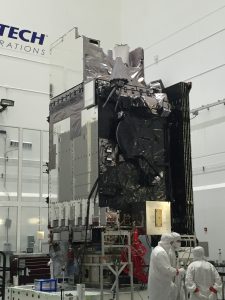 Harris Corporation’s second Advanced Baseline Imager (ABI), built for the National Oceanic and Atmospheric Administration’s (NOAA) weather-monitoring mission, is scheduled to launch March 1 on the GOES.
Harris Corporation’s second Advanced Baseline Imager (ABI), built for the National Oceanic and Atmospheric Administration’s (NOAA) weather-monitoring mission, is scheduled to launch March 1 on the GOES.
The ABI will be controlled by the Harris-built enterprise ground system and deliver three times the amount of spectral coverage in four times the resolution and five times faster than older GOES satellites. It will provide better weather monitoring information more quickly throughout the western half of the United States and support forecasting and public safety efforts.
NOAA’s GOES-R, now called GOES-East, launched in November 2016 and includes the first ABI that monitors the Western Hemisphere. It became operational late last year and covers the eastern half of the hemisphere, while GOES-S will cover the western half. GOES-East has tracked devastating hurricanes in the Gulf of Mexico, the Caribbean and along the East Coast, providing the National Weather Service with more detail on each storm’s structure and path than available from previous weather satellites.
GOES-S will improve fire detection and severe weather forecasting, helping to protect residents in the western U.S. The ABI instrument has day-and-night thermal detection and 30-second revisit time capabilities providing firefighters more insight into fire intensity, behaviour and how it will spread.
“The ABI’s increased capabilities will help save lives and provide new insight and better forecasts for severe weather, fog, volcanic ash and many other environmental issues,” said Eric Webster, vice president and general manager, Harris Environmental Solutions.
Harris ABIs also will be included on GOES-T and GOES-U, which will complete NOAA’s latest generation of geostationary weather satellites. The entire series will be controlled by Harris’ enterprise ground system.












Add Comment